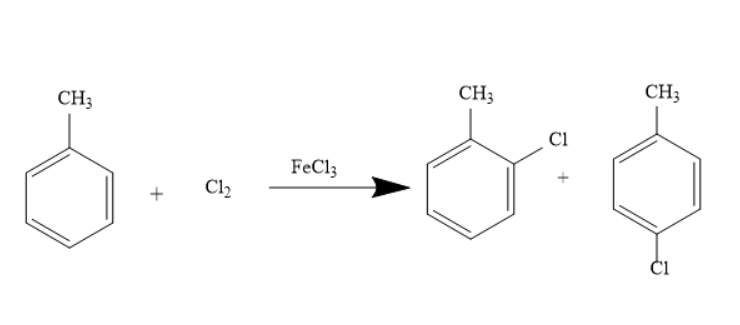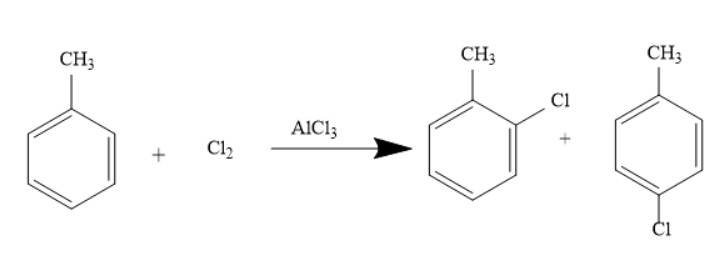
How will you obtain o-chlorotoluene from toluene?
Answer
350.4k+ views
Hint: Chlorotoluene exists in 3 isomeric forms- Ortho, Meta, and Para. This consists of a disubstituted benzene ring with one Chloro and one Methyl group. o-chlorotoluene or ortho chlorotoluene is actually a name given to 1-Chloro 2-Methyl toluene. It is a colorless liquid with a strong irritating odour.
Complete answer:
The preparation of o-chlorotoluene is possible from toluene in presence of Chlorine and Ferric chloride. This reaction is called the Chlorination reaction. It is a typical Electrophilic substitution reaction. Here Ferric chloride acts as the catalyst. The reaction is represented as under-

This reaction can also occur when toluene reacts in the presence of Chlorine and Aluminium Chloride. The reaction is represented as under-

The Chlorine is broken into $C{l^ - }$ and $C{l^ + }$ ions in the presence of a liquid catalyst. This $C{l^ + }$ ion (Electrophile) attacks the phenyl ring and hence results in the product. The Methyl group attached acts as an electron-donating group. The Methyl group in the toluene is ortho and para directing and thus the electrophilic substitution reaction occurs at the ortho and para position.
However, if the reaction occurs in absence of a catalyst the substitution occurs at the methyl group to form trichloromethyl benzene.
Note:
o-chlorotoluene has wide industrial applications. It is used as a bactericide and insecticide. It is also used in the preparation of dyes, Synthetic rubber, dyes, and pharmaceuticals. It is also used as a solvent and chemical intermediate. It can irritate the eye and skin when it comes in contact with it.
Complete answer:
The preparation of o-chlorotoluene is possible from toluene in presence of Chlorine and Ferric chloride. This reaction is called the Chlorination reaction. It is a typical Electrophilic substitution reaction. Here Ferric chloride acts as the catalyst. The reaction is represented as under-

This reaction can also occur when toluene reacts in the presence of Chlorine and Aluminium Chloride. The reaction is represented as under-

The Chlorine is broken into $C{l^ - }$ and $C{l^ + }$ ions in the presence of a liquid catalyst. This $C{l^ + }$ ion (Electrophile) attacks the phenyl ring and hence results in the product. The Methyl group attached acts as an electron-donating group. The Methyl group in the toluene is ortho and para directing and thus the electrophilic substitution reaction occurs at the ortho and para position.
However, if the reaction occurs in absence of a catalyst the substitution occurs at the methyl group to form trichloromethyl benzene.
Note:
o-chlorotoluene has wide industrial applications. It is used as a bactericide and insecticide. It is also used in the preparation of dyes, Synthetic rubber, dyes, and pharmaceuticals. It is also used as a solvent and chemical intermediate. It can irritate the eye and skin when it comes in contact with it.
Recently Updated Pages
Glucose when reduced with HI and red Phosphorus gives class 11 chemistry CBSE

The highest possible oxidation states of Uranium and class 11 chemistry CBSE

Find the value of x if the mode of the following data class 11 maths CBSE

Which of the following can be used in the Friedel Crafts class 11 chemistry CBSE

A sphere of mass 40 kg is attracted by a second sphere class 11 physics CBSE

Statement I Reactivity of aluminium decreases when class 11 chemistry CBSE

Trending doubts
10 examples of friction in our daily life

The correct order of melting point of 14th group elements class 11 chemistry CBSE

Difference Between Prokaryotic Cells and Eukaryotic Cells

One Metric ton is equal to kg A 10000 B 1000 C 100 class 11 physics CBSE

State and prove Bernoullis theorem class 11 physics CBSE

What organs are located on the left side of your body class 11 biology CBSE




